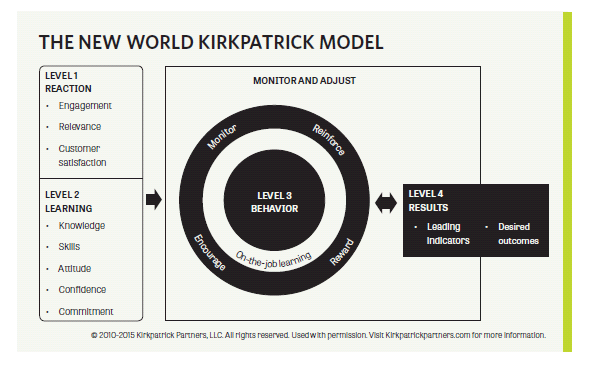ATD Blog
Updating the Four Levels for the New World
Fri Sep 04 2015

Bookmark

Simple, isn’t it? All you need to do is show that your training is effective and that it has created training effectiveness. How can this be done, especially with limited time, money, and resources? A straightforward and time-tested model for accomplishing this is the Kirkpatrick Model, or the four levels. But this model requires some basic updating to address new world needs.
Enter the New World Kirkpatrick Model
LEVEL 4: RESULTSTo what degree targeted outcomes occur as a result of the learning event(s) and subsequent reinforcement
LEVEL 3: BEHAVIORTo what degree participants apply what they learned during training when they are back on the job
LEVEL 2: LEARNINGTo what degree participants acquire the intended knowledge, skills, and attitudes based on their participation in the learning event
LEVEL 1: REACTIONTo what degree participants react favorably to the learning event
Levels 1 and 2 of the New World Kirkpatrick Model provide data related to effective training. These levels measure the quality of the training program and the degree to which it resulted in knowledge and skills that can be applied on the job. These measurements are useful primarily to the training function to measure internally the quality of the programs they design and deliver.
Levels 3 and 4 provide the needed data related to training effectiveness. These levels measure on-the-job performance and subsequent business results that occur, in part, because of training and reinforcement. Training effectiveness data are key to demonstrating the value that the training program has contributed to the organization and are typically the type of data that key business stakeholders find valuable.
You may be wondering why this piece introduced Level 4 first, and not Level 1. The reason is that this is how successful training professionals organize their work when planning, implementing, and evaluating training programs.
Why the Old-School Way Isn’t Working
When you start training with a focus on the Level 4 results you need to accomplish, efforts are automatically focused on what is most important. Conversely, if you follow the common, old-school approach to planning and implementing your training, thinking about how you will evaluate Level 1 reaction, then Level 2 learning, then Level 3 behavior . . . it’s easy to see why few people get to Level 4 results in this fashion.
Set yourself apart from and ahead of the crowd by using the four levels upside down—start every project by first considering the leading indicators you plan to influence, and articulate how this will contribute to the Level 4 result of your organization. Then, think about what really needs to occur on the job to produce good results (Level 3). Consider next what training or other support is required for workers to perform well on the job (Level 2). Finally, consider what type of training will be conducive to imparting the required skills successfully (Level 1).
To learn more about what is new about the Four Levels and how to create an effective training evaluation plan for any program so that you can show the organizational value of your work, check out the TD at Work “The Four Level—An Update.”
Want to learn more about the most essential topics in learning and development and learning technologies? Check out our brand new event, Core 4, in New Orleans this September.
More from ATD
